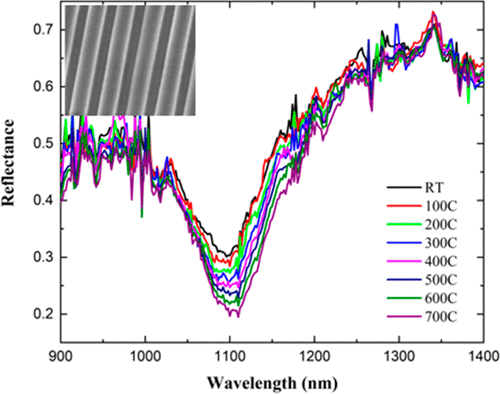当前位置:
X-MOL 学术
›
ACS Photonics
›
论文详情
Our official English website, www.x-mol.net, welcomes your
feedback! (Note: you will need to create a separate account there.)
Remote Sensing of High Temperatures with Refractory, Direct-Contact Optical Metacavity
ACS Photonics ( IF 6.5 ) Pub Date : 2020-01-16 , DOI: 10.1021/acsphotonics.9b01450 Krishnakali Chaudhuri , Urcan Guler 1 , Shaimaa I. Azzam , Harsha Reddy , Soham Saha , Ernesto E. Marinero , Alexander V. Kildishev , Vladimir M. Shalaev , Alexandra Boltasseva
ACS Photonics ( IF 6.5 ) Pub Date : 2020-01-16 , DOI: 10.1021/acsphotonics.9b01450 Krishnakali Chaudhuri , Urcan Guler 1 , Shaimaa I. Azzam , Harsha Reddy , Soham Saha , Ernesto E. Marinero , Alexander V. Kildishev , Vladimir M. Shalaev , Alexandra Boltasseva
Affiliation

|
In this work, temperature-dependent optical properties of refractory plasmonic transition metal nitrides and dielectric thin films are utilized to design and realize a planar, direct-contact, nanophotonic metacavity for remote, all-optical sensing of a wide range of surface temperatures (from room temperature to above 1000 °C). The proposed hybrid metacavity device integrates the plasmonic cavity with a planar metasurface that utilizes refractory material components, namely, titanium nitride (TiN) and silicon nitride (Si3N4), and operates in a spectral wavelength window of 900–1400 nm. The unique feature of this approach is that metacativy is located directly on the hot surface, while other components are kept remote. The thermally variant optical properties of the constituent materials (TiN, Si3N4) enable metacavity operation with a strong polarization-dependent resonant reflectance response. At the cavity resonance, relative amplitude variations of above 30% are detected in the temperature-dependent reflectance spectra that act as the read-out from the experimentally demonstrated sensor. The proposed high-efficiency, planar optical refractory sensor located directly on hot surfaces also allows for great scalability. The device enables true remote all-optical measurements by keeping other ancillary systems outside of the hot ambient conditions and, therefore, is especially relevant for applications in harsh environments.
中文翻译:

耐火的,直接接触的光学偏腔对高温的遥感
在这项工作中,利用难熔等离子体过渡金属氮化物和介电薄膜的随温度变化的光学特性来设计和实现平面,直接接触的纳米光子超腔,以实现对大范围表面温度的远程全光学传感(从室温至1000°C以上)。提出的混合超腔设备将等离子体腔与平面超表面集成在一起,该平面利用耐火材料成分即氮化钛(TiN)和氮化硅(Si 3 N 4),并在900-1400 nm的光谱波长窗口内工作。这种方法的独特之处在于,元突变直接位于热表面上,而其他组件则保持远离。组成材料(TiN,Si 3 N 4)可实现具有强偏振相关共振反射响应的超腔操作。在腔共振时,在与温度相关的反射光谱中检测到超过30%的相对幅度变化,这些变化是从实验证明的传感器中读出的。所提出的直接位于热表面上的高效平面光学耐火传感器还具有很大的可扩展性。该设备通过将其他辅助系统置于高温环境之外,从而实现了真正的远程全光测量,因此,特别适用于恶劣环境中。
更新日期:2020-01-17
中文翻译:

耐火的,直接接触的光学偏腔对高温的遥感
在这项工作中,利用难熔等离子体过渡金属氮化物和介电薄膜的随温度变化的光学特性来设计和实现平面,直接接触的纳米光子超腔,以实现对大范围表面温度的远程全光学传感(从室温至1000°C以上)。提出的混合超腔设备将等离子体腔与平面超表面集成在一起,该平面利用耐火材料成分即氮化钛(TiN)和氮化硅(Si 3 N 4),并在900-1400 nm的光谱波长窗口内工作。这种方法的独特之处在于,元突变直接位于热表面上,而其他组件则保持远离。组成材料(TiN,Si 3 N 4)可实现具有强偏振相关共振反射响应的超腔操作。在腔共振时,在与温度相关的反射光谱中检测到超过30%的相对幅度变化,这些变化是从实验证明的传感器中读出的。所提出的直接位于热表面上的高效平面光学耐火传感器还具有很大的可扩展性。该设备通过将其他辅助系统置于高温环境之外,从而实现了真正的远程全光测量,因此,特别适用于恶劣环境中。











































 京公网安备 11010802027423号
京公网安备 11010802027423号